10 Exercises To Focus On If You Have Limited Time
 By Jeremy Gentles, MA, CSCS
By Jeremy Gentles, MA, CSCS
Open a fitness magazine and you often see some half dressed ?fitness model? performing some silly exercises like tricep kickbacks, machine bicep curls or stability ball crunches. Most of us have time constraints in our lives and should not waste time going to the gym to perform exercises that have very little impact on strength, endurance or health.
While it seems like a no brainer, the object of strength training is to gain strength. In order to gain a substantial amount of strength, you must perform exercises that require you to produce significant amounts of force. I am sorry to say, but stability ball crunches and tricep kickbacks do not allow for much force production and the strength gains with these exercises will be minimal. The object of cardiovascular or endurance training is to increase cardiovascular endurance. Increasing cardiovascular endurance does not require expensive treadmills, bikes or elliptical machines. Get the most bang for your buck with these brief guidelines and exercises.
Guidelines
When it comes to strength training, your priority should be with exercises that require movement across more than one joint, known as complex movements. Exercises requiring movement across one joint are known as single joint or simple movements. When movement is required across more than one joint multiple muscle groups will be involved and force production will generally be high. When you are crunched for time, do not waste time performing single joint movements. Instead, work multiple muscle groups with one complex movement/exercise. While it never hurts to have access to plenty of free weights at a gym, most of the strength training exercises described below can be performed at home with limited equipment.
Exercise equipment companies imply that you can get a superior cardiovascular workout using one of their treadmills or elliptical machines. Running, jogging, hiking and walking are excellent forms of cardiovascular exercise and the only thing you need is a good pair of shoes. Are there instances where a recumbent bike or aquatic exercise would be recommended? Of course. If someone is extremely limited by their weight or there are orthopedic issues to consider, alternative forms of cardiovascular exercise are an option. However, for most individuals, getting a good cardiovascular workout should not require a gym membership or expensive equipment.
Lower Body Strength Training
1. SquatsSquats can be performed holding dumbbells at your side, using a Smith machine or with a barbell as described below. Target Muscle Group: Quadriceps Preparation/Setup: Adjust a barbell on a rack so that the barbell is the height of your upper chest. Position yourself under the barbell where the barbell is behind your neck and high on the back of your shoulders. Grasp the barbell out to the sides and dismount the barbell from the rack. Stand with your feet about shoulder width apart. Hold the dumbbells at your side. Movement/Execution: Flex your knees allowing them to move forward slightly while simultaneously flexing your hips allowing them to move back. Keep your back straight while also keeping your knees and feet in-line and pointing forward. Keep flexing your knees until your thighs are parallel or slightly lower than parallel to the floor. Return by extending your knees and hips until you are standing straight up. Repeat and rack the barbell when complete. |
|
 |
|
2. DeadliftsDeadlifts can be performed using dumbbells or a barbell as described below. Target Muscle Group: Hamstrings Preparation/Setup: Stand with your feet shoulder width apart or slightly narrower than shoulder width apart. You can stand on the floor or on a short and stable platform. Bend down by flexing your knees and keep your back straight. Grasp the barbell with an overhand or alternating/mixed grip shoulder width apart. Lift the barbell by extending your legs and standing up. Movement/Execution: With your knees slightly flexed, lower the barbell towards your feet. Keep your back straight and continue lowering the barbell until you can flex your hips no further. Return by extending your hips, lifting the barbell up until you are standing straight up once again. Repeat. Comments: There may be a tendency to allow your shoulders to stretch forward. Keep your shoulders back throughout the movement. |
|
 |
|
3. Walking LungesWalking lunges can be performed with a barbell high on the back of your shoulders or with dumbbells held at your side. Target Muscle Group: Gluteus Maximus Movement/Execution: Step forward with your right or left leg. As your foot makes contact with the floor, you should first land on your heel, followed by your forefoot. Flex the lead leg and hip, lowering your body until your knee nearly contacts the floor. Then, stand up on your forward leg with some assistance from your rear leg. Lunge forward with your rear or opposite leg and perform the same series of movements described previously. Repeat. |
|
Upper Body Strength Training
4. Bench PressThe bench press can be performed with dumbbells or with a barbell as described below. Target Muscle Group: Pectoralis Major Preparation/Setup: Lie supine (on your back) on a bench. Grasp the barbell with an overhand grip wider than shoulder width apart while the barbell is still in the rack. Dismount the barbell from the rack and position the barbell over your upper chest. Movement/Execution: Flex your elbows and lower the barbell to your upper chest. Return by extending your elbows, pressing the barbell back up until your arms are extended. Comments: Do not allow your back to arch off the bench.
|
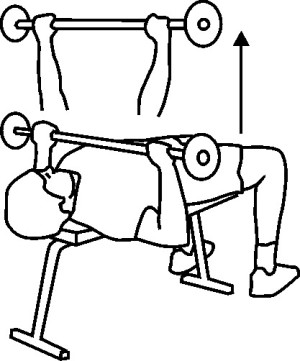 |
 |
|
5. One-Arm Dumbbell RowsTarget Muscle Group: Back (General) Preparation/Setup: Kneel on the side of a bench by placing your knee on the bench. Lean forward and rest your hand on the bench. The opposite leg should be positioned slightly back and to the side. Reach down and grasp the dumbbell from the floor with palm facing in. Movement/Execution: Flex your elbow and pull the dumbbell to your side until the dumbbell makes light contact with your ribs. Your upper arm should be slightly higher than parallel with the floor. Return by lowering the dumbbell until your arm is extended and your shoulder is stretched forward towards the floor. Repeat. Comments: Unilateral exercises such as this one should be performed weak side first. |
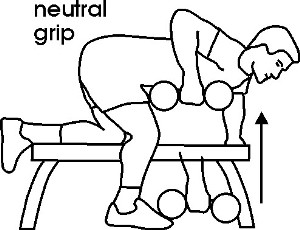 |
 |
|
6. Lat PulldownsThis is the only exercise on this list that requires a machine or device other than dumbbells, barbell and/or bench. Target Muscle Group: Lattisimus Dorsi Preparation/Setup: Grasp the cable bar with a wide overhand grip. Sit facing the machine and place your thighs under the pads. Movement/Execution: Pull the cable bar down to your upper chest. Return by extending your elbows and shoulders. Repeat. |
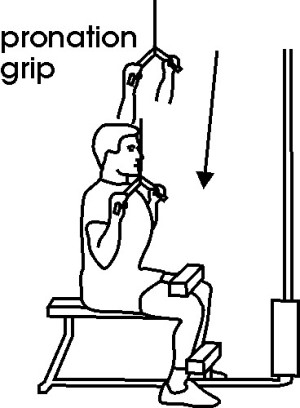 |
 |
|
7. Dumbbell Shoulder PressTarget Muscle Group: Anterior Deltoid Preparation/Setup: Stand or sit and grasp a dumbbell in each hand using an overhand grip. Bring the dumbbells to the side of the each shoulder with your wrists in line with or directly above your elbows. Movement/Execution: Press the dumbbells over your head until arms are fully extended. Return by flexing your arms and lowering the dumbbells back to the sides of your shoulders. |
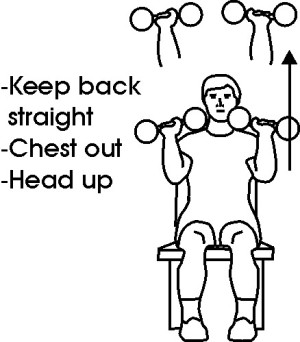 |
 |
|
8. Sit-UpsTarget Muscle Group: Rectus Abdominus Preparation/Setup: Lie on your back (supine) with your hands behind your head. Flex your knees and hips and place your feet on the floor. Movement/Execution: Curl up and raise your torso off the floor. Return without allowing your upper torso to rest on the floor. Repeat. Comments: Instead of placing your hands behind your head, you may also cross your arms over your chest or extend your arms in front of you. |
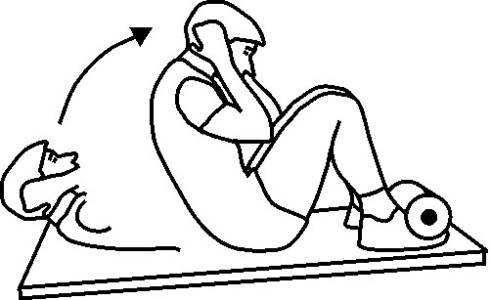 |
 |
|
9. Lying Leg-Hip RaisesTarget Muscle Group: Rectus Abdominus Preparation/Setup: Lie supine (on your back) on a bench or the floor. Reach behind you and grasp the bench near your head. If you are lying on the floor, reach behind you and grasp a strong and stationary object. If additional weight is needed, place weight between your ankles. Movement/Execution: Raise your legs by flexing your hips. Continue raising your legs until your hips are fully flexed and raised from the bench. You can keep your legs straight bringing your feet towards your head or flex your legs bringing your knees towards your shoulders. Return by extending your hips and lowering your legs. Repeat. |
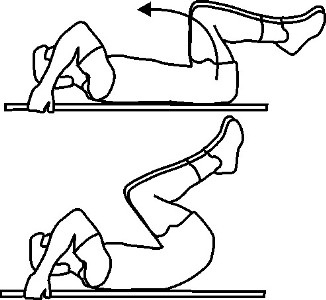 |
10. Cardiovascular/ Endurance Exercise
As mentioned previously, running, jogging, hiking and walking are all excellent forms of cardiovascular exercise. They do not require a gym membership and can be done pretty much anytime, anywhere. Another aspect of cardiovascular exercise often overlooked is the fact that it is cumulative. If you don?t have time during the day to spend 30 minutes walking or running, divided sessions throughout the day will provide very similar results (ex. 2 fifteen minute sessions or 3 ten minute sessions).
All of the exercises described above do not need to be performed on the same day. If you are uneasy about your ability to perform any of the exercises above, find a well qualified personal trainer or exercise physiologist to teach you proper technique.



